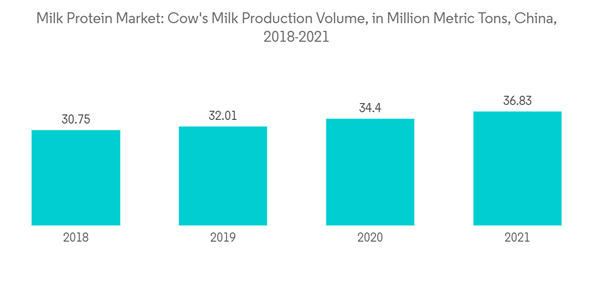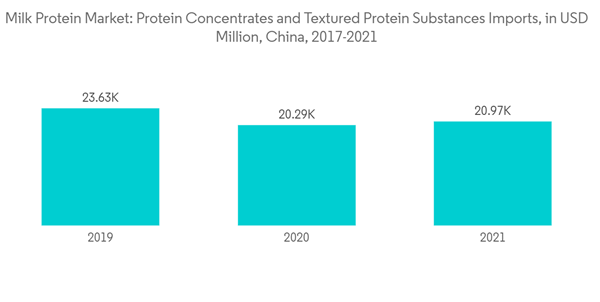Key Highlights
- The China milk protein market is majorly driven by the growing dairy sector and increasing consumer demand for convenient and healthy dairy products. Owing to rising health concerns like digestive and gut disorders, consumers are inclined toward dairy products that aid gut health, which is supporting the market's growth. Additionally, the demand for milk protein ingredients from infant formula manufacturers is on the rise as awareness regarding the benefits of infant formula across the country. The increasing imports into the country can depict the demand for infant milk formula.
- For instance, according to the Food and Agriculture Organization (FAO), in 2022, the volume of infant milk formula imported to China amounted to 280 thousand metric tons, up from 273 thousand tons in the previous year.
- Additionally, due to its delightful taste and extensive variety, yogurt effortlessly integrates into one's diet, with dairy producers placing a strong emphasis on promoting the probiotic advantages of their yogurt products. These factors, combined with the introduction of versatile ingredients by industry players, are not only fueling demand but also propelling the market's expansion.
- Moreover, new rules and regulations by Chinese authorities in reforming the protein requirements for milk and formulated milk powder products designed for children, adults, and older people are expected to create more opportunities for the players in the market to develop more innovative and good quality milk protein ingredients.
- In February 2023, China's introduction of the world's strictest nutrient standards for infant formula forced infant formula makers to invest heavily to re-make, test, certify, and re-register their products for China before potentially conducting new marketing campaigns. This reform is further expected to bring significant changes in the industry, with bigger domestic and international brands likely to increase their spending on research and developmental activities, resulting in the introduction of more quality ingredients.
- Similarly, small and medium players are expected to have more innovative opportunities to tap into. However, the rise in the acceptance of alternative proteins like plant proteins among consumers and manufacturers considering them as a significant alternative to be incorporated in their products is expected to have the potential to hamper the market's growth during the forecast period.
China Milk Protein Market Trends
Increasing Consumer Demand for Nutritious Food
- The demand for nutritious food in China is rising from all age groups, mainly for infant food formulas, which is driving the market's growth. Baby food essentially contains specialized nutrition with a well-balanced composition aimed as closely as possible at matching breast milk.
- Additionally, these factors, coupled with the increasing concern of parents regarding infant foods and their milk protein content, are driving the market's growth. Moreover, a considerable increase in the number of working mothers is further fueling the demand for nutritious infant and baby food in the country. Such factors have led manufacturers to innovate their ingredients and develop more enhanced and functional milk proteins.
- In addition to the growing demand from infant product manufacturers, the growing nutrient-conscious population and fitness enthusiasts are expanding the application capabilities of milk proteins in various products like nutrient-rich bars, protein bars, ready-to-drink-beverages, and drinks, thus generating more opportunities for the players in the market. In line with this, manufacturers are also focused on offering milk protein ingredients that align with the consumers' and manufacturers' demands.
- For instance, Fonterra offers milk proteins like milk protein isolate 4900 and softbar 1000, among others, in the Chinese market under its brand SureProtein, claiming that these ingredients enable high protein, low sugar bar formulation supporting formulation flexibility and stable texture over the bar shelf life. Similarly, its milk protein isolate 4900 is claimed to offer low lactose, high micellar casein with heat stability and a great milky flavor, finding its application in various infant food products.
- Moreover, the increasing milk production in the country is also supporting the market and players to grow and expand with low production costs. For instance, according to the National Bureau of Statistics of China, in 2022, China had an output of around 39.3 million metric tons of cow's milk, the highest volume in recent years and also increased when compared to the previous year in which the cow's milk production volume in the country was only 36.83 million metric tons. Thus, high milk production in the country is supporting the growth of milk protein manufacturers.
Milk Protein Concentrates is the Fastest Growing Segment in the Market
- Milk protein concentrates (MPCs) have emerged over the past two decades as significant new dairy ingredients that are used increasingly in food formulation and nutritional beverages in China. Milk protein concentrates with higher protein content are often used in China to enhance the protein content of foods and beverages by imparting a clean dairy flavor without adding significant levels of lactose and allowing food and beverage formulators to develop lactose-free products, avoid product defects, such as browning due to Maillard reaction.
- Additionally, they often come with higher protein content compared to other ingredients and are also lower in price, making them ideal for manufacturers to use in their applications. Manufacturers use milk protein concentrates for their nutritional and functional properties, and the high protein, low lactose ratio makes MPC suitable for protein-fortified beverages and low-carbohydrate foods.
- Owing to this growing demand, the imports of protein concentrate into the country have seen an increase in 2021, according to the UN Comtrade. For instance, in 2021, the imports of protein concentrates and textured protein into China accounted for about USD 20,965 thousand, which increased from USD 20,289 thousand when compared to the previous year.
- Moreover, milk protein concentrates are often suitable for a variety of applications in cultured products like spoon-able yogurt, drinking yogurt, yogurt mousses, nutritional yogurt bars, and more, making it compatible with many of the brand's other health and wellness ingredients to deliver multi-functional benefits across many food and drink offerings.
- Such factors are attracting manufacturers to prefer milk protein concentrates over other types of milk proteins, thus driving the segment's growth in the country. Furthermore, the rising trend of clean-label and organic food ingredients is creating more opportunities in the segment, allowing players to innovate with their ingredients to further boost growth.
China Milk Protein Industry Overview
The China milk protein market is fragmented, with various national and international players participating in the market share. The major players in this market are Arla Foods amba, Fonterra Co-operative Group Limited, Groupe Lactalis, Kerry Group PLC, and Morinaga Milk Industry Co. Ltd. Several small and international players are involved in the manufacturing and distribution of milk protein ingredients in the country. Furthermore, companies engage in capacity expansions, strategic partnerships, product portfolio expansions, and mergers & acquisitions to gain a competitive edge. They are keen on investing in research and developmental activities to innovate with milk protein ingredients and emerge as a top player in the market.Additional Benefits:
- The market estimate (ME) sheet in Excel format
- 3 months of analyst support
This product will be delivered within 2 business days.










